Vaca Frita Vs Ropa Vieja: The Difference Between The 2 Popular Cuban Beef Dishes
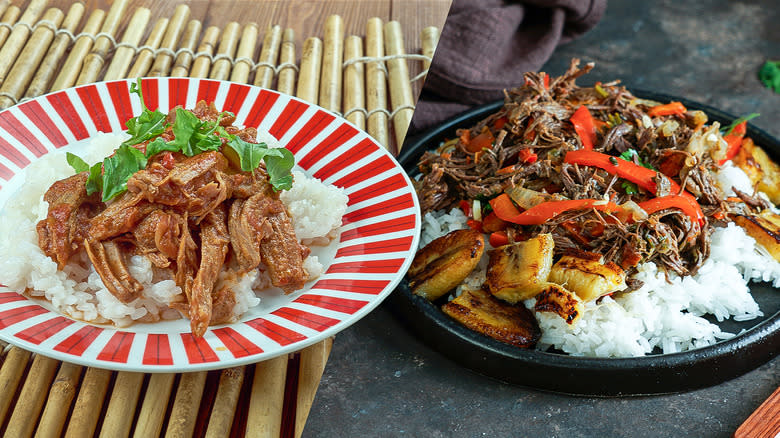
Cuban food is beloved around the world for its amazing array of dishes and wide-ranging, diverse influences, and yet, two of its most popular creations are both beef recipes that don't seem to have many differences upon first glance. Cuba's cuisine comes from its long history as a colony and destination for world trade, bringing together Spanish and African ingredients and cooking techniques with local Caribbean traditions. Many Cuban foods, like arroz con pollo and picadillo, mix a common Latin American heritage with local twists, but some have become more uniquely associated with Cuba. Two of the biggest are the shredded beef dishes vaca frita and ropa vieja, both delicious testaments to the creativity and history of Cuban cooking.
Both vaca frita and ropa vieja are based on a unique method of cooking that involves boiling and shredding steak. They are also both served as the main course centerpiece of traditional Cuban meals with rice and beans, as well as plantains, salads, and bread. But, despite their similar beginnings and accompaniments, the texture and flavor of the two dishes can be quite different, with ropa vieja ending up as a hearty stewed mixture with tomatoes, while vaca frita is served crisp with sharper, acidic flavoring. The two dishes show how different influences can produce unique results from the same core ingredients.
Read more: Your Guide To The Different Cuts Of Steak
What Is Ropa Vieja?
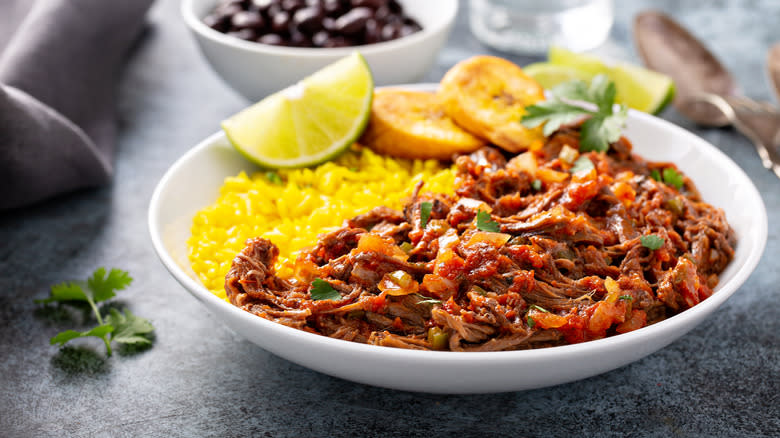
Ropa vieja is Cuba's famous dish of shredded steak and tomato sauce, which traces its origins back hundreds of years. According to Revolución de Cuba, the dish is thought to have first come from Spain, where it was eaten by the Sephardic Jewish community. Similar to dishes like baked beans in New England, ropa vieja was a slow-cooked dish made with affordable staple ingredients that could be made the day before the Sabbath, when people were forbidden to work. There is evidence that it dates back over 500 years on the Iberian Peninsula, and it eventually made its way across the Atlantic to the island of Cuba after Spain colonized the island, and many Jewish settlers moved there to escape persecution in Europe, according to ReformJudaisim.org. The name ropa vieja, itself means "old clothes," and comes from the wet and shredded appearance of the dish.
Traditionally ropa vieja is made by poaching or boiling flank steak in water with vegetables. Separately, a sauce is made using tomatoes, onions, and peppers with spices like cumin, oregano, and paprika. The steak is taken out of the water, shredded, and then added to the sauce, which helps keep the lean meat moist and tender after boiling. Some modern variations of the dish keep the ingredients mostly the same but braise the steak directly in the tomato sauce instead of cooking it separately. Either method produces a deeply savory, meaty stew mixture, perfect for serving alongside rice and beans.
What Is Vaca Frita?
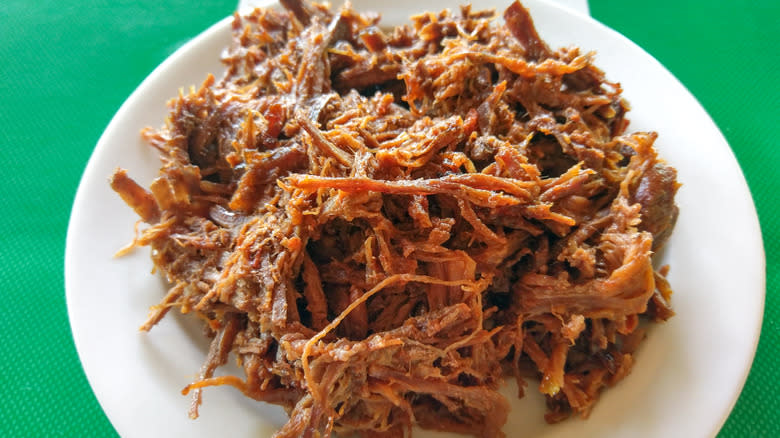
Unlike the more imaginative name of ropa vieja, the translation of the name vaca frita tells you exactly what you are getting: fried cow. It's also a shredded beef dish, but it has no tomato sauce and gets cooked in oil to produce a crispy final texture. The origins of vaca frita trace back to enslaved people in Cuba and the Canary Islands, another colony of Spain. Flank and skirt steak was the meat reserved for slaves because it was cheap and tough. Vaca frita was developed by cooks as a way to use skilled techniques and other simple, easily available ingredients to transform a difficult chunk of beef into something flavorful and delicious, and it has endured through the years to become a favorite among Cubans.
Like ropa vieja, vaca frita starts with the steak being boiled with aromatics, then taken out and shredded once it's cooked through. The shredded meat then gets marinated with a simple mixture of oil, salt, lime juice, and garlic to add flavor and keep it moist. The marinated beef shreds are pan-fried in oil with sliced onions until they are crispy and brown on the edges. Although usually served with rice and black beans, vaca frita also gets used as a sandwich filling or as a topping for bean stews.
Ropa Vieja Is Flavored With Tomatoes And Vegetables
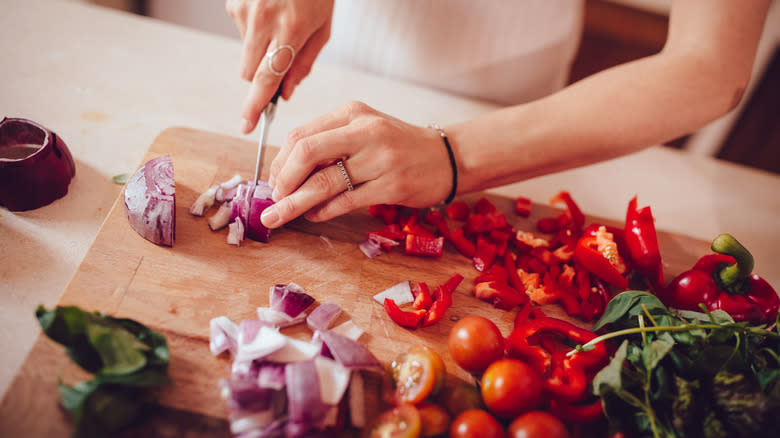
Despite starting with the same base, the flavors of ropa vieja and vaca frita can end up quite different. Ropa vieja has a deeper, more umami taste reminiscent of beef stews. The combination of cooked tomatoes, onions, and peppers gives it a light sweetness and more vegetal notes. It also frequently uses more spices than vaca frita for additional complexity. If ropa vieja is made by braising the meat directly in the sauce, it becomes even richer, as the beefy flavor will more thoroughly meld with the whole dish.
Vaca frita has a simpler flavor but is no less tasty. The lime juice marinade lends it a bit of brightness and a cleaner acidity in contrast with ropa vieja. While some recipes do call for additional spices like paprika or oregano, you don't want to make this dish too complex. Without the saucy mixture and extra vegetables, it's much more beef-forward. But the real defining taste is the salty, fatty element the beef gets from the pan-frying in oil. The sauteed onions add a little sweetness and bite themselves, but, with vaca frita, you are first and foremost getting fried meat, with all the greasy, comforting flavors that entails.
Vaca Frita Is Crispy And Pan-Fried
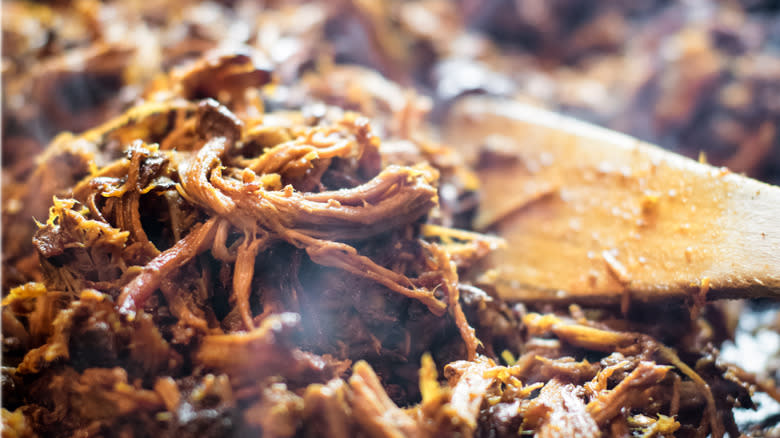
Beyond the fried flavor, the texture really sets vaca frita apart from ropa vieja. The double cooking process for vaca frita creates a unique contrast of tender and crispy, even compared to other pan-fried dishes. Because vaca frita must be boiled until it can be shredded, it loses a lot of its moisture — and it's made from a cut of meat that already isn't very fatty to begin with. While the marinade will add some of this back, the lack of moisture means it browns up quickly and gets incredibly crispy. The shreds, however, are still thick enough that, while one side gets crispy, the rest of the meat stays relatively juicy.
Ropa vieja has no such contrast or crispness, aside from a little bite from the vegetables. It's a quintessential stewed meat with a softer, more buttery texture. It also has much of the moisture boiled out like vaca frita, but the sauce more than replaces it and really rehydrates the beef. However, this also makes it more versatile as a pairing for dishes that can use a saucy topping, especially ones that are crispy themselves. While rice is common, ropa vieja's texture means it can be spooned over crispy smashed and fried plantains, mashed plantains, or even yucca fries.
Both Dishes Make Use Of Cheap Flank Or Skirt Steak
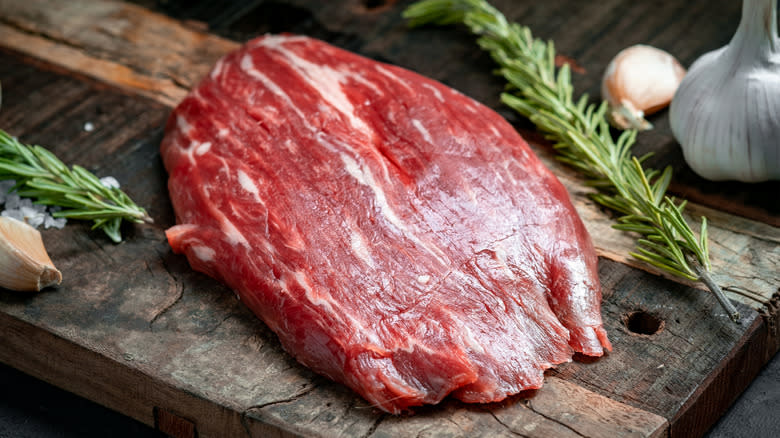
Flank steak is the basis of both ropa vieja and vaca frita first and foremost for its affordability but also its unique texture. Flank steak is from the abdominal area of the cow, which gets a lot of work. This means it has long, prominent muscle fibers clearly running through the meat. While this makes it tough, it's also why flank steak shreds into long strands in such a satisfying way. That's important for both dishes because the long shreds provide lots of surface area to more easily reabsorb liquid after being cooked, which is great for such a lean cut. Skirt steak is similarly lean and cheap, so it is sometimes substituted in these dishes, but it doesn't shred quite as well as flank.
Beyond that, the use of flank steak speaks to both dishes' origins and place in Cuban society. Both vaca frita and ropa vieja trace their roots back to marginalized groups who needed to subsist off of substandard cuts of meat. They are versatile dishes that are made from cheap ingredients, while still being delicious and beloved. While they are no longer directly tied to the people that originated them, the affordability and functionality of both dishes are what has helped them endure as cultural symbols of Cuba, both in the country and in the Cuban diaspora in the United States.
Read the original article on Tasting Table.

